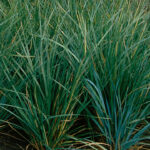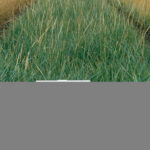Élyme étroit
Leymus angustus
Description générale
L’élyme étroit est une herbe touffue de longue durée avec un système racinaire étendu. Elle est remarquée pour sa haute tolérance à la salinité, sa capacité à résister à la sécheresse et sa capacité à rester verte jusqu’à l’automne. Les tiges atteignent jusqu’à 120 cm de hauteur, avec une croissance des feuilles principalement basale. Les feuilles sont rigides, droites et de couleur vert à vert bleuté. Les épis de graines sont des épis épais. Les graines produites sont grandes et se détachent facilement de l’épi. L’élyme étroit a des feuilles plus larges et plus rigides sur des plantes plus robustes que le seigle sauvage russe.
Type
Herbe cultivée.
Origine
Sibérie et Mongolie. Variétés développées au Canada.
Longévité
Au moins 20 ans. L’implantation est difficile et lente.
Utilisation
Pâturage, stockage.
Période d’utilisation optimale
Élyme de l’Altai pousse plus lentement au printemps que de nombreuses autres herbes, mais peut être pâturé une fois que suffisamment de feuilles basales se sont développées. Il peut être pâturé en continu ou en rotation. Il se conserve bien en stock grâce à ses longues feuilles basales dressées qui sèchent bien et restent accessibles pour le bétail.
Récupération après utilisation
Nécessite un minimum de 60 à 80 jours de récupération après pâturage. Laissez au moins 15 cm (6 po) pour permettre la repousse. Un pâturage léger en été suivi d’un stockage peut produire un rendement modeste de fourrage de haute qualité.
Appétence/Valeur nutritionnelle
L’appétence est plus élevée plus tard dans la saison de croissance qu’au printemps. Un pâturage léger en été suivi de stockage peut produire un rendement modeste de fourrage de haute qualité. L’élyme d’Altai a environ 65 % de digestibilité de la matière sèche et 10 % de protéines brutes à maturité en automne. La qualité est maintenue jusqu’en hiver.
Précipitations annuelles min/max (mm)
300 mm / 460 mm
Tolérance à la sécheresse
Haute tolérance. Les racines profondes (jusqu’à 3 mètres de profondeur) peuvent tirer parti de l’humidité du sol en profondeur et des niveaux d’eau élevés. Continue de croître lentement et reste verte.
Tolérance aux inondations
Résiste à une à deux semaines d’inondation au printemps.
Rusticité hivernale
Haute rusticité hivernale.
Préférence de texture du sol
L’élyme d’Altai s’établit mieux sur des sols limoneux et argileux, mais peut croître sur tous les types de sols. Il offre une excellente production dans les zones sèches avec des nappes phréatiques élevées. Bien qu’il puisse prospérer sur des sols sablonneux, il nécessite une bonne humidité pendant les années d’établissement.
Contrôle de l’érosion
Utilisation limitée, voire nulle, pour le contrôle de l’érosion.
Tolérance à la salinité
Tolérance élevée.
Tolérance à l’acidité
Tolérance modérée.
Tolérance à l’alcalinité
Tolérance modérée à élevée.
Graines par kg
133,000 graines/kg (60,000 graines/lb)
Mélanges suggérés
L’élyme d’Altai est souvent semé seul ou dans un mélange simple avec des espèces telles que le trèfle incarnat ou le pois fourrager. Semer d’autres fourrages à des angles de 90 degrés par rapport aux rangs d’élyme d’Altai peut réduire la compétition entre les espèces.
Facilité d’établissement
Les semis d’élyme d’Altai sont lents à pousser et difficiles à établir. Cela constitue un facteur limitant majeur pour l’utilisation de l’élyme d’Altai. Il concurrence mal les mauvaises herbes, les cultures compagnons ou les autres semis de fourrages. Il est noté qu’il faut jusqu’à trois ans pour s’établir complètement pour une utilisation.
Compétitivité
L’élyme d’Altai est compétitif une fois établi. Il est un concurrent très faible pendant la phase d’établissement.
Considérations de gestion
Une gestion attentive de la concurrence durant l’établissement permettra d’obtenir des populations végétales adéquates pour une production optimale. L’élyme d’Altai reste le plus productif lorsqu’il est pâturé en automne. Bien que ce soit une espèce durable, elle n’a jamais été largement répandue.
Saskatchewan Dryland Forage Species Adaptation Tool, USDA Plants Database, Manitoba Forage Adaptation and Comparison Guide, Alberta Forage Manual
Altai wildrye is adapted to the driest areas of the Bunchgrass and Interior Douglas-fir zones in the southern part of the Central Interior, and has in the past been established in demonstration plots in the Bunchgrass zone. It is notoriously difficult to establish, which limits its practical application.
Altai wildrye is adapted to the driest areas of the Bunchgrass, Ponderosa Pine and Interior Douglas-fir zones, and has in the past been established in demonstration plots in the Bunchgrass zone. It is notoriously difficult to establish, which limits its practical application.


